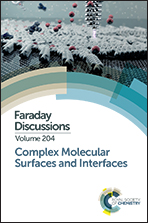Pt–dipyridyl tetrazine metal–organic network on the Au(100) surface: insights from first principles calculations†
Abstract
Metal–organic coordination networks with active metal centers are a promising class of materials for next-generation catalysts. Motivated by experimental observations of the formation of a Pt–Dipyridyl Tetrazine (DT) metal–organic network on the Au(100) surface [D. Skomski et al., J. Am. Chem. Soc., 2014, 136, 9862], we carried out density functional theory based calculations on the same system. In this discussion, we demonstrate that the strong interaction between DT ligands and Pt metal centers makes the network stable and that the Pt centers become positively charged by donating their electrons to the DT ligands, resulting in +2 oxidation states for the Pt centers. We further show that the Au substrate withdraws electrons from and hybridizes with the dz2 orbital of the Pt centers, altering their electronic structure and related properties. Furthermore, we find that the Pt centers can absorb SO2via donor–acceptor interactions, leading to the formation of σ-bonds in which Pt dz2 orbitals act as electron donors, and that the strength of the resultant σ-bond depends on the registry of the Pt centers with the Au(100) surface. Finally, we identify factors, such as the specificity of the ligands and the substrate, and the fullness of the outer shell of the metal centers, that may affect the chemical properties of the metal centers. We suggest modifications (and replacement) of these factors as one of the ways to tune and design metal–organic coordination networks for next-generation catalysts.
- This article is part of the themed collection: Complex Molecular Surfaces and Interfaces


 Please wait while we load your content...
Please wait while we load your content...